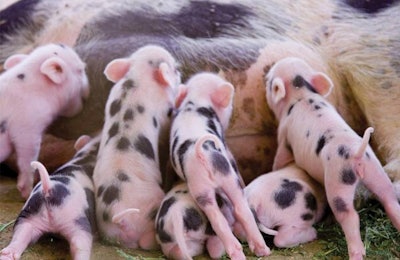
Approximately 15 percent of sows are culled due to lameness, according to the National Animal Health Management Services (NAHMS). Swine producers that have adopted hoof trimming as part of their management say that it’s an investment that more than pays for itself with fewer culls and more productive sows. But according to researchers, the key isn’t for you to carry around a pair of clippers in your back pocket for emergency trims. The key is to implement a farm protocol that includes both preventative and corrective claw trimming care, starting with careful observation.
Monitor locomotion in the gilt herd
Watch for pigs that have toenails longer than 2 inches (5.8 cm). If the hoof length is about 3 inches or 7 centimeters, then it is time to trim down the hoof. An easier way may be to notice how evenly a sow walks on all four legs and if she caters to one leg. Keep in mind that pigs carry 58 percent of their weight on their front hooves so they may not cater as much to a front hoof as they would to a back hoof.
Robert Dove, an associate professor at the University of Georgia, advises to start watching for hoof issues early rather than later. Specifically, start monitoring gilts when they enter the breeding herd. “Research shows that gilts are already showing some hoof issues prior to breeding,” he said. “Go ahead and do corrective trimming to make sure one toe isn’t overgrown or that the medial nail isn’t overgrowing on the lateral side.”
Schedule trimming when sows are least stressed
The benefit to doing corrective trimming on gilts when they enter the breeding herd is that you’re avoiding putting them in a chute during gestation or lactation. Chutes that pick up sows by their bellies may cause problems with implantation if the sow is put in the chute early in her gestation. Likewise, putting sows in a chute when they’re close to the end of their gestation puts extra pressure on their full udder and belly full of piglets. “Ideally, you need to trim the sow’s claws when she is 30 to 40 days from implantation or when she is open,” said Dove.
Plan a preventative and corrective trimming protocol
Corrective trimming prevents long toenails from breaking off on their own. If a nail tears off too far back on the hoof, then you’ll have a lame sow. Claws that break off are also more jagged and tend to catch on the floor and gates causing the hoof to get bruised.
Experts at Zinpro Corporation recommend using clippers to clip off the end of the toe, but to do so in small increments as seen in Figure 1. This helps you to make sure you don’t clip too far back into the hoof. The ideal length of the claw is about 2 inches (5.8 cm), though it may be shorter on younger pigs.

After clipping the toenails back, use a grinder to smooth the end of the claw so that it is round instead of blunt and jagged. This will prevent the claw from catching on the floor and bruising.
Shape the hoof
Sow’s claws are hard and require a grinder to properly trim them down to size. Use a grinder to help shape the hoof so that it is angular as seen in Figure 2. Zinpro advises using an angle grinder to shave down the top and inside of the hoof so that it is straight instead of round and concave. However, only use a grinder if the sow is properly restrained in a chute to prevent the grinder from bouncing off the sow and hurting her or you. Grinders should not be used if you are using a snare or just picking up the sow’s feet to trim.
Balance the sole
The amount that you need to grind down the sole of the sow’s claw will depend on the flooring she’s on. Sows that are on concrete flooring tend to wear down their hooves more than sows that are on smoother flooring. Likewise, you may spend more time grinding the bottom of the hooves if your sows are in group housing as opposed to maternity pens. Dove said researchers speculate that sows in maternity pens paw at the floor more often than sows in group housing, thus the sows in maternity pens wear down the bottom of their hooves more than other sows.
Use a grinder to carefully shave down the bottom of the hoof so that the sow can distribute her weight evenly on the hoof, as shown in Figure 3. And use a hoof knife to trim the heel. Be careful that you don’t trim too far and hurt the live tissue. Zinpro advised to not trim the heel to match the sole of the hoof since the heel is the shock absorber when the sow walks.
Trim the dew claws
Unlike corrective claw trimming that require a sow to be restrained in a chute, long dewclaws can be carefully clipped back while a sow is feeding her piglets. Keep in mind that dew claws are an important part of sow locomotion. Dew claws that are overgrown or ripped off can cause a sow to go lame. With that in mind, use clippers to trim the dewclaws so that they are even with the top of the hoof. But be careful, trimming the dewclaw too short puts you at risk of cutting into live tissue. See Figure 4.
Follow protocol to prevent feet and leg issues
Remember that it is easier to prevent a hoof issue with a routine trim than it is to fix a lame sow. The protocols that work best on the farm are the protocols that involve routine care rather than just emergency trims. Routine claw trimming has the potential to prevent a percentage of your herd from being culled due to feet issues. And if sows are getting their hooves trimmed instead of leaving the herd then you won’t have to pay for a replacement gilt to take her place, resulting in a more productive herd and profitable farm.

















